The Western Lake Erie Islands (WLEI) rank fourth for global biodiversity compared to all eco-districts in Ontario within the Great Lakes Eco-region. This archipelago of 22 islands, including 9 in Canada support globally significant biodiversity and important ecological functions. The WLEI are a mosaic of aquatic and terrestrial resources, crossing the boundary of Ohio and Ontario. Globally rare shoreline, alvar, forest communities and species occur on most of the islands. The islands and coastal areas provide critical stopover habitat for migratory land and water birds, and breeding sites for colonial nesting waterbirds. The waters of the region are shallow, warm, relatively clear and high in nutrients, making this the most productive aquatic habitat in the Great Lakes. The reefs and coasts provide spawning and nursery habitat for walleye and other native fish.
The Canadian Islands provide some of the most biologically diverse natural habitats in the Country and have one of the highest densities of species at risk. The Ontario Natural Heritage Information Centre currently tracks over 150 species on the islands, 11 of which are globally rare. Most of these species are not currently listed by the Committee on the Status of Endangered Wildlife in Canada (COSEWIC), but would be candidates for formal designation under Ontario’s new Endangered Species Act. This extraordinary number of species at risk requires ecosystem-based approaches to conservation and parallel community oriented approaches to education and stewardship programs. Just as managing the landscape as a whole is essential for effective and efficient protection of these species, the education of the whole person is crucial to all stewardship efforts, and to the survival of humankind and wildlife.
Assistance for this project was provided by The Ministry of Natural Resources.
Eastern Fox Snake
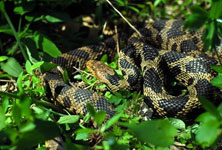
Photo ‘Courtesy of Parks Canada’
Biology: The Eastern Fox Snake (Elaphe vulpina gloydi) is Ontario’s second largest snake, usually growing to about one metre in length, though some individuals can grow up to 1.75 metres. Eastern Fox Snakes are yellowish-brown in colour with dark blotches down the back and a row of smaller blotches along each side of their body. They are usually found near water in both marsh and woodland, and often near human habitation. They will enter barns and travel along roads and ditches when hunting for small rodents and birds, which are killed by constriction. If you are lucky enough to have a Fox Snake living near your house or cottage, you won’t have to worry about mice or rats! In late summer, females lay their eggs in rotting logs. As temperatures drop in the fall, snakes will converge on local communal over-wintering sites, called hibernacula, and the snakes may travel several kilometres to these underground sites.
Status: Threatened Provincially and Nationally
Why at Risk: The Eastern Fox Snake is thought to have declined in Ontario as wetlands were drained and shorelines were developed for cottages. Accidental kills as snakes cross roads have also impacted populations. At the same time, many are mistaken for rattlesnakes and deliberately killed or collected for the illegal pet trade.
Eastern Spiny Softshell Turtle
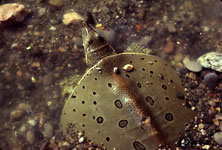
Photo ‘Courtesy of Parks Canada’
Biology: The Eastern Spiny Softshell (Apalone spinifera spinifera) is also known as the “pancake turtle” because of its rather flat, round, leathery upper shell, or carapace. The long neck and elongated, tubular snout allow this turtle to breathe while almost fully submerged and virtually unseen. Softshells ambush prey by lying concealed in the bottom of streams or wetlands in the mud. This is a highly aquatic turtle associated with lakes and large rivers. It rarely ventures far from the shoreline, and may be seen basking on beaches, sandbars, logs and rocks.
Status: Threatened Provincially and Nationally.
Why at Risk: Habitat loss is the main factor responsible for the decline of this turtle. Other threats include predation by other wildlife on eggs and young, environmental contaminants, and the accidental taking of turtles by the commercial fishery.
Smallmouth Salamander
Biology: The Small-mouthed Salamander (Ambystoma texanum) is 11 to 18 cm long and is dark brown or black with irregular gray or yellowish markings. Their undersides are black and may have small flecks. During the non-breeding season it spends its life underground in leaf litter or soil, or in the burrows of other animals. It emerges for a brief period in early spring to breed in permanent or temporary pools.
While found in most parts of the Island, Smallmouths are most common at Fish Point where they are found in wooded areas and breed in early spring in seasonal ponds. At the end of courtship, male salamanders release a sperm packet which is picked up by the female and stored until the approximately 700 eggs are ready to be fertilized and laid. After 3 or 4 weeks, the eggs hatch and the newly-born larvae begin to feed on aquatic organisms. By fall, these nocturnal creatures will have transformed into small salamanders and will be ready to hibernate for the winter. Pelee Island is the only place in Canada where the Smallmouth exists.
Status: Endangered Provincially and Nationally
Why at Risk: The cutting of trees, clearing of logs, and drainage of wooded wetlands are the main threats to the Smallmouth Salamander. In particular, the opening of the canopy can cause the breeding ponds to dry too quickly in late spring, and the larvae are stranded before they have transformed. The removal of rotting logs threatens salamanders because old logs provide shelter and food.
Kentucky Coffeetree
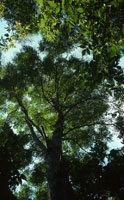
Photo ‘Courtesy of Parks Canada’
Biology: The first part of the Latin name for the Kentucky Coffeetree (Gymnocladus dioica) means “naked branch”, because this tree spends up to 9 months of the year without any leaves. The leaves appear in late spring and are very large, up to one metre long and 60 cm wide. The tree produces long, dark brown leathery pods that contain up to seven rounded, dark, hard-coated seeds. It is reported that early settlers used the seeds as a coffee substitute, however this practice is highly inadvisable as the beans contain poisonous substances. The Kentucky Coffeetree prefers sunny areas in woodlands and at the edges of marshes, although it will tolerate a wide variety of growing conditions in full sun.
Status: Threatened Provincially and Nationally
Why at Risk: The extensive deforestation and draining of wetlands has most likely been the reason for the Coffeetree’s decline in southwestern Ontario. At the same time, the complex life history of the Kentucky Coffeetree may be the reason that it is a rare species. In order to reproduce, insects must carry the pollen from the flowers from a male Coffeetree to the flowers of a female Coffeetree. On Pelee Island, there are several Coffeetrees of only one sex that have been established at the north end making seed production impossible. There is only one location on Pelee where both sexes produce viable seeds.
Red Mulberry
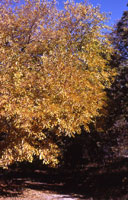
Photo ‘Courtesy of Parks Canada’
Biology: Red mulberry (Morus rubra) is a small tree that reaches heights of only about 10 metres and often no more than 5 metres on the Island. The bark is reddish–brown and smooth in young trees, but flaky in mature trees. The coarsely toothed leaves may be either simple or lobed and the tops of the leaves are roughly textured, while the undersides are soft and fuzzy. The fruit is juicy and edible, and resembles a blackberry.
Status: Endangered Provincially and Nationally
Why at Risk: Red Mulberry reaches its northern range limits in Ontario and probably was never common here. At present, hybridization with the introduced white mulberry (Morus alba), a native of eastern Asia, poses the gravest threat to the survival of Red Mulberry stands in Ontario. At present very few populations of pure Red Mulberry remain. The species appears to have low reproductive success here, and damage by snails and slugs may hinder the establishment of new seedlings. Habitat destruction has resulted in the loss of a number of Red Mulberry populations and continues to be a threat.
Acadian Flycatcher
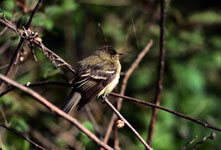
Photo ‘Courtesy of Parks Canada’
Biology: The Acadian Flycatcher (Empidonax virescens) is a small olive-green songbird that has a pale eye ring, light-coloured wing bars and a short brown bill with a slightly hooked tip. It is best identified by its song, an emphatic (“pi-zza”). This flycatcher’s preferred habitat is the forest interior of large tracts of mature, shady, maple-beech forest. It builds a distinctive hanging nest on a forked branch in a tree or shrub. The Acadian Flycatcher is an insectivorous (insect-eating) bird and it hunts by darting out from a perch to capture prey on the wing. In Ontario, it is believed that there are fewer than 40 breeding pairs scattered throughout suitable habitat in the Carolinian Forest zone. Several birds were recorded on territory in the Island alvar in the 1980’s. Since then, several spring records exist of singing males around Fish Point.
Status: Endangered Provincially and Nationally
Why at Risk: The major threat is habitat loss due to forest clearing and fragmentation. Other factors contributing to the risks have not been adequately studied and, therefore, are not fully understood.
Yellow-Breasted Chat
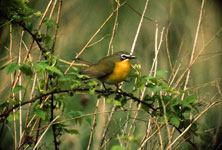
Photo ‘Courtesy of Parks Canada’
Features: The Yellow-breasted Chat (Icteria virens) is a large secretive warbler, which spends much of its time skulking in hedge-rows. The song is extremely varied and consists of a weird assortment of clicks, liquid whistles and even chuckles.
Status: Special Concern Provincially and Nationally
Why at Risk: The Chat is a species that depends on succession habitats. A succession habitat is one where clearings have become overgrown with scrub and thickets. These habitats have disappeared with continued natural succession and as land was cleared for crops and development. On Pelee Island, the Chat population is found in private and protected reserves. Fire management of select areas will be needed to maintain scrub and thickets, as well as open areas for this species.
Wild Hyacinth
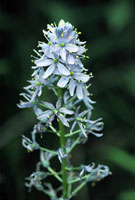
Photo ‘Courtesy of Parks Canada’
Biology: The beautiful pale blue flowers with bright yellow anthers of Wild Hyacinth (Camassia scilloides) blooms in mid-May. This lily prefers habitat of open deciduous forests on limestone areas. The large bulb of the Wild Hyacinth, where the plant stores food for over-wintering, was apparently sought after as food by some North American Indians. In Canada, Wild Hyacinth is only found naturally on Pelee, Middle, Hen, Middle Sister and North Harbour Islands. On Pelee Island, Wild Hyacinth has been found in the Middle Point woods, the Stone Road Alvar and at Fish Point.
Status: Threatened Provincially and Nationally
Why at Risk: As is common for most species, habitat destruction is an ongoing threat. Other threats to the Wild Hyacinth population in Ontario include the collection of bulbs by growers and gardeners, the picking of flowers, accidental trampling, and the invasion of exotic species that are highly competitive.
Eastern Prickly Pear Cactus
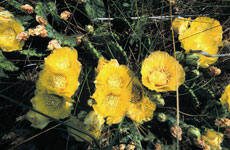
Photo ‘Courtesy of Parks Canada’
Biology: The Eastern Prickly Pear Cactus (Opuntia humifusa) is a fleshy, low sprawling cactus whose numerous broad pads are armed with bristles and spines. The green pads become swollen in the summer and desiccated in the winter and bright yellow, waxy flowers are borne on the edges of the pads. The edible fruits are green, ripening to red though Ontario cacti seldom produce fruit and reproduce chiefly through pads breaking off of parent plants and taking root nearby. The Eastern Prickly Pear grows in sandy areas with no shading.
Status: Endangered Provincially and Nationally
Why at Risk: Ontario populations are very restricted. Fish Point’s population has been seriously depleted by picking, and the encroachment of vegetation and natural disturbances. A boardwalk and trail has been constructed to keep visitors on the trail to avoid accidental trampling.
Grey Fox
Biology: The Grey Fox (Urocyon cinereoargenteus) is a secretive animal about the size of a small dog. It is grey, with a reddish chest and sides of the belly. It is also distinguished from the Red Fox by its smaller size and black-tipped tail (the Red Fox has a white-tipped tail.) In Ontario, the Grey Fox prefers deciduous forests. It climbs well and will take refuge in a tree when startled. It feeds on a variety of small mammals, birds, eggs, fruit, and insects. Little is known about the breeding population on Pelee Island. On occasion, dens are located amidst boulders or in hollow logs. Most sightings occur in winter when tracks are visible in the snow and an absence of leaves makes them more visible.
Status: Threatened Provincially and Nationally
Why at Risk: Little is known about historic population trends of the Grey Fox in Ontario and it is likely that the history of the fox in southern Ontario is likely one of periodic occupation, as individuals invaded from the United States and established small populations, and then disappearance as climate and catastrophic events occurred. Fox hunting and competition from coyotes can leave populations at greater risk.
